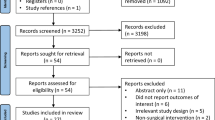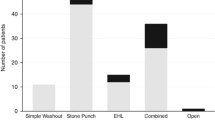Abstract
Stone disease in patients with spinal cord injury is a source of morbidity and mortality. Previous studies have indicated a decrease in infection-based urolithiasis in recent decades. We aimed to identify changes in stone composition and surgical outcomes in patients with para and quadriplegia over time. A retrospective review of para and quadriplegic patients from 1986 to 2011 who underwent surgical intervention for urolithiasis was performed, identifying 95 patients. The Mantel–Haenszel Chi square test was used to compare change in stone composition over time. The mean patient age was 44.0 years (range 18–88) and treatment included percutaneous nephrolithotomy (PCNL) 40 (42.1 %), ureteroscopy 28 (29.5 %), shock wave lithotripsy (SWL) 26 (27.4 %), and nephrectomy 1 (1 %). Overall stone-free status was found in 47.4 % with 19.0 % requiring a repeat procedure. The median hospital stay for patients undergoing SWL was 2.5 days, ureteroscopy 5 days, and PCNL 6 days. Infection-based stone composition was identified in 23 patients (36.5 %). We evaluated the linear change in percent of each stone component over time and identified increasing components of calcium oxalate dihydrate (p = 0.002) and calcium carbonate (p = 0.009). However, over a period of 25 years, the incidence of infection-based stone did not change (p = 0.57). Para and quadriplegic patients with urolithiasis can be difficult to treat surgically with prolonged hospitalizations, low stone-free status, and often require additional procedures. Despite improvements in antibiotic agents and management of neurogenic bladders, infection-based calculi continue to be a significant source of morbidity to this patient population.
Similar content being viewed by others
References
Hansen RB, Biering-Sorensen F F, Kristensen JK (2007) Urinary calculi following traumatic spinal cord injury. Scand J Urol Nephrol 41:115–119
Hall MK, Hackler RH, Zampieri TA et al (1989) Renal calculi in spinal cord-injured patient: association with reflux, bladder stones, and foley catheter drainage. Urology 34:126–128
Chen Y, DeVivo MJ, Stover SL et al (2002) Recurrent kidney stone: a 25-year follow-up study in persons with spinal cord injury. Urology 60:228–232
Burr RG (1978) Urinary calculi composition in patients with spinal cord lesions. Arch Phys Med Rehabil 59:84–88
Donnellan SM, Bolton DM (1999) The impact of contemporary bladder management techniques on struvite calculi associated with spinal cord injury. BJU Int 84:280–285
Matlaga BR, Kim SC, Watkins SL et al (2006) Changing composition of renal calculi in patients with neurogenic bladder. J Urol 175:1716–1719
Gnessin E, Mandeville JA, Handa SE et al (2011) Changing composition of renal calculi in patients with musculoskeletal anomalies. J Endourol 25:1519–1523
Ost MC, Lee BR (2006) Urolithiasis in patients with spinal cord injuries: risk factors, management, and outcomes. Curr Opin Urol 16:93–99
Nikakhtar B, Vaziri ND, Khonsari F et al (1981) Urolithiasis in patients with spinal cord injury. Paraplegia 19:363–366
Parks JH, Worcester EM, Coe FL et al (2004) Clinical implications of abundant calcium phosphate in routinely analyzed kidney stones. Kidney Int 66:777–785
Gault MH, Chafe L (2000) Relationship of frequency, age, sex, stone weight and composition in 15,624 stones: comparison of results for 1980 to 1983 and 1995 to 1998. J Urol 164:302–307
Deliveliotis C, Picramenos D, Kostakopoulos A et al (1994) Extracorporeal shock wave lithotripsy in paraplegic and quadriplegic patients. Int Urol Nephrol 26:151–154
Lawrentschuk N, Pan D, Grills R et al (2005) Outcome from percutaneous nephrolithotomy in patients with spinal cord injury, using a single-stage dilator for access. BJU Int 96:379–384
Acknowledgments
None.
Conflict of interest
Dr. Amy Krambeck, HistoSonics, Consultant; Dr. Marisa M. Clifton, M.D.; Matthew T. Gettman, M.D.; David E. Patterson, M.D.; Laureano Rangel—No competing financial interests exist. All authors have no conflicts of interest.
Ethical standard
This study has been approved by the Mayo Clinic Institutional Review Board and has therefore been performed in accordance with the ethical standards laid down in the 1964 Declaration of Helsinki and its later amendments. This is a retrospective review and therefore informed consent could not feasibly be obtained from every patient. This study does not contain prospective clinical studies and all patients were deidentified prior to inclusion in our data set.
Author information
Authors and Affiliations
Corresponding author
Rights and permissions
About this article
Cite this article
Clifton, M.M., Gettman, M.T., Patterson, D.E. et al. The change in upper tract urolithiasis composition, surgical treatments and outcomes of para and quadriplegic patients over time. Urolithiasis 42, 415–419 (2014). https://doi.org/10.1007/s00240-014-0681-0
Received:
Accepted:
Published:
Issue Date:
DOI: https://doi.org/10.1007/s00240-014-0681-0




